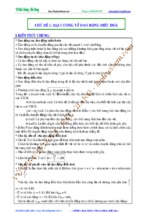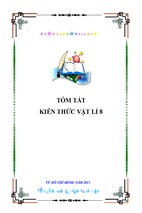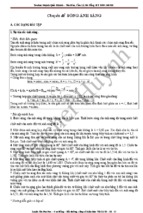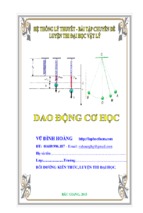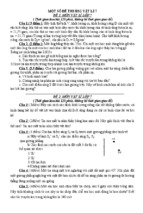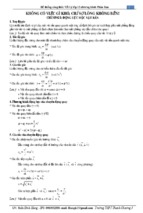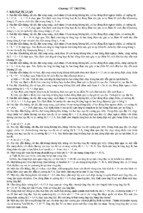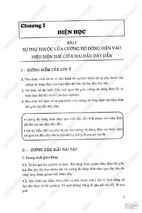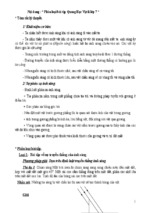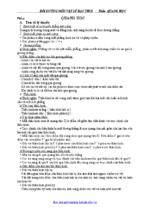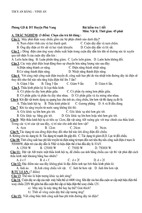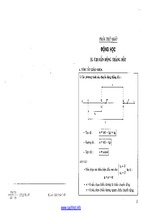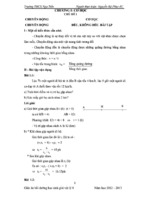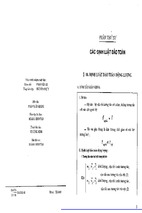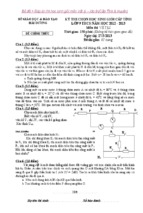CHAPTER 1
1.1. Given the vectors M = −10ax + 4ay − 8az and N = 8ax + 7ay − 2az , find:
a) a unit vector in the direction of −M + 2N.
−M + 2N = 10ax − 4ay + 8az + 16ax + 14ay − 4az = (26, 10, 4)
Thus
a=
(26, 10, 4)
= (0.92, 0.36, 0.14)
|(26, 10, 4)|
b) the magnitude of 5ax + N − 3M:
(5, 0, 0) + (8, 7, −2) − (−30, 12, −24) = (43, −5, 22), and |(43, −5, 22)| = 48.6.
c) |M||2N|(M + N):
|(−10, 4, −8)||(16, 14, −4)|(−2, 11, −10) = (13.4)(21.6)(−2, 11, −10)
= (−580.5, 3193, −2902)
1.2. Given three points, A(4, 3, 2), B(−2, 0, 5), and C(7, −2, 1):
a) Specify the vector A extending from the origin to the point A.
A = (4, 3, 2) = 4ax + 3ay + 2az
b) Give a unit vector extending from the origin to the midpoint of line AB.
The vector from the origin to the midpoint is given by
M = (1/2)(A + B) = (1/2)(4 − 2, 3 + 0, 2 + 5) = (1, 1.5, 3.5)
The unit vector will be
m=
(1, 1.5, 3.5)
= (0.25, 0.38, 0.89)
|(1, 1.5, 3.5)|
c) Calculate the length of the perimeter of triangle ABC:
Begin with AB = (−6, −3, 3), BC = (9, −2, −4), CA = (3, −5, −1).
Then
|AB| + |BC| + |CA| = 7.35 + 10.05 + 5.91 = 23.32
1.3. The vector from the origin to the point A is given as (6, −2, −4), and the unit vector directed from the
origin toward point B is (2, −2, 1)/3. If points A and B are ten units apart, find the coordinates of point
B.
With A = (6, −2, −4) and B = 13 B(2, −2, 1), we use the fact that |B − A| = 10, or
|(6 − 23 B)ax − (2 − 23 B)ay − (4 + 13 B)az | = 10
Expanding, obtain
36 − 8B + 49 B 2 + 4 − 83 B + 49 B 2 + 16 + 83 B + 19 B 2 = 100
or B 2 − 8B − 44 = 0. Thus B =
B=
√
8± 64−176
2
= 11.75 (taking positive option) and so
2
1
2
(11.75)ax − (11.75)ay + (11.75)az = 7.83ax − 7.83ay + 3.92az
3
3
3
1
1.4. given points A(8, −5, 4) and B(−2, 3, 2), find:
a) the distance from A to B.
|B − A| = |(−10, 8, −2)| = 12.96
b) a unit vector directed from A towards B. This is found through
aAB =
B−A
= (−0.77, 0.62, −0.15)
|B − A|
c) a unit vector directed from the origin to the midpoint of the line AB.
a0M =
(3, −1, 3)
(A + B)/2
= √
= (0.69, −0.23, 0.69)
|(A + B)/2|
19
d) the coordinates of the point on the line connecting A to B at which the line intersects the plane z = 3.
Note that the midpoint, (3, −1, 3), as determined from part c happens to have z coordinate of 3. This
is the point we are looking for.
1.5. A vector field is specified as G = 24xyax + 12(x 2 + 2)ay + 18z2 az . Given two points, P (1, 2, −1) and
Q(−2, 1, 3), find:
a) G at P : G(1, 2, −1) = (48, 36, 18)
b) a unit vector in the direction of G at Q: G(−2, 1, 3) = (−48, 72, 162), so
aG =
(−48, 72, 162)
= (−0.26, 0.39, 0.88)
|(−48, 72, 162)|
c) a unit vector directed from Q toward P :
aQP =
(3, −1, 4)
P−Q
= √
= (0.59, 0.20, −0.78)
|P − Q|
26
d) the equation of the surface on which |G| = 60: We write 60 = |(24xy, 12(x 2 + 2), 18z2 )|, or
10 = |(4xy, 2x 2 + 4, 3z2 )|, so the equation is
100 = 16x 2 y 2 + 4x 4 + 16x 2 + 16 + 9z4
2
1.6. For the G field in Problem 1.5, make sketches of Gx , Gy , Gz and |G| along the line y = 1, z = 1, for
0 ≤ x ≤ 2. We find√
G(x, 1, 1) = (24x, 12x 2 + 24, 18), from which Gx = 24x, Gy = 12x 2 + 24,
Gz = 18, and |G| = 6 4x 4 + 32x 2 + 25. Plots are shown below.
1.7. Given the vector field E = 4zy 2 cos 2xax + 2zy sin 2xay + y 2 sin 2xaz for the region |x|, |y|, and |z| less
than 2, find:
a) the surfaces on which Ey = 0. With Ey = 2zy sin 2x = 0, the surfaces are 1) the plane z = 0, with
|x| < 2, |y| < 2; 2) the plane y = 0, with |x| < 2, |z| < 2; 3) the plane x = 0, with |y| < 2, |z| < 2;
4) the plane x = π/2, with |y| < 2, |z| < 2.
b) the region in which Ey = Ez : This occurs when 2zy sin 2x = y 2 sin 2x, or on the plane 2z = y, with
|x| < 2, |y| < 2, |z| < 1.
c) the region in which E = 0: We would have Ex = Ey = Ez = 0, or zy 2 cos 2x = zy sin 2x =
y 2 sin 2x = 0. This condition is met on the plane y = 0, with |x| < 2, |z| < 2.
1.8. Two vector fields are F = −10ax + 20x(y − 1)ay and G = 2x 2 yax − 4ay + zaz . For the point P (2, 3, −4),
find:
a) |F|: F at (2, 3, −4) = (−10, 80, 0), so |F| = 80.6.
b) |G|: G at (2, 3, −4) = (24, −4, −4), so |G| = 24.7.
c) a unit vector in the direction of F − G: F − G = (−10, 80, 0) − (24, −4, −4) = (−34, 84, 4). So
a=
F−G
(−34, 84, 4)
=
= (−0.37, 0.92, 0.04)
|F − G|
90.7
d) a unit vector in the direction of F + G: F + G = (−10, 80, 0) + (24, −4, −4) = (14, 76, −4). So
a=
F+G
(14, 76, −4)
=
= (0.18, 0.98, −0.05)
|F + G|
77.4
3
1.9. A field is given as
G=
(x 2
25
(xax + yay )
+ y2)
Find:
a) a unit vector in the direction of G at P (3, 4, −2): Have Gp = 25/(9 + 16) × (3, 4, 0) = 3ax + 4ay ,
and |Gp | = 5. Thus aG = (0.6, 0.8, 0).
b) the angle between G and ax at P : The angle is found through aG · ax = cos θ . So cos θ =
(0.6, 0.8, 0) · (1, 0, 0) = 0.6. Thus θ = 53◦ .
c) the value of the following double integral on the plane y = 7:
�
0
�
0
4� 2
0
4� 2
0
G · ay dzdx
� 4
� 4� 2
25
25
350
×
7
dzdx
=
dx
(xa
+
ya
)
·
a
dzdx
=
x
y
y
2 + 49
2 + 49
x2 + y2
x
x
0
0
0
�
�
� �
1
−1 4
tan
− 0 = 26
= 350 ×
7
7
1.10. Use the definition of the dot product to find the interior angles at A and B of the triangle defined by the
three points A(1, 3, −2), B(−2, 4, 5), and C(0, −2, 1):
a) Use RAB = (−3,
√ 1,
√7) and RAC = (−1, −5, 3) to form RAB · RAC = |RAB ||RAC | cos θA . Obtain
3 + 5 + 21 = 59 35 cos θA . Solve to find θA = 65.3◦ .
b) Use RBA = (3,√−1,√−7) and RBC = (2, −6, −4) to form RBA · RBC = |RBA ||RBC | cos θB . Obtain
6 + 6 + 28 = 59 56 cos θB . Solve to find θB = 45.9◦ .
1.11. Given the points M(0.1, −0.2, −0.1), N(−0.2, 0.1, 0.3), and P (0.4, 0, 0.1), find:
a) the vector RMN : RMN = (−0.2, 0.1, 0.3) − (0.1, −0.2, −0.1) = (−0.3, 0.3, 0.4).
b) the dot product RMN · RMP : RMP = (0.4, 0, 0.1) − (0.1, −0.2, −0.1) = (0.3, 0.2, 0.2). RMN ·
RMP = (−0.3, 0.3, 0.4) · (0.3, 0.2, 0.2) = −0.09 + 0.06 + 0.08 = 0.05.
c) the scalar projection of RMN on RMP :
RMN · aRMP = (−0.3, 0.3, 0.4) · √
(0.3, 0.2, 0.2)
0.05
=√
= 0.12
0.09 + 0.04 + 0.04
0.17
d) the angle between RMN and RMP :
−1
θM = cos
�
RMN · RMP
|RMN ||RMP |
�
−1
= cos
4
�
0.05
√
√
0.34 0.17
�
= 78◦
1.12. Given points A(10, 12, −6), B(16, 8, −2), C(8, 1, −4), and D(−2, −5, 8), determine:
a) the vector projection of RAB + RBC on RAD : RAB + RBC = RAC = (8, 1, 4) − (10, 12, −6) =
(−2, −11, 10) Then RAD = (−2, −5, 8) − (10, 12, −6) = (−12, −17, 14). So the projection will
be:
�
�
(−12, −17, 14) (−12, −17, 14)
(RAC · aRAD )aRAD = (−2, −11, 10) ·
= (−6.7, −9.5, 7.8)
√
√
629
629
b) the vector projection of RAB + RBC on RDC : RDC = (8, −1, 4) − (−2, −5, 8) = (10, 6, −4). The
projection is:
�
�
(10, 6, −4) (10, 6, −4)
(RAC · aRDC )aRDC = (−2, −11, 10) · √
= (−8.3, −5.0, 3.3)
√
152
152
c) the angle between RDA and RDC : Use RDA = −RAD = (12, 17, −14) and RDC = (10, 6, −4).
The angle is found through the dot product of the associated unit vectors, or:
�
�
(12, 17, −14) · (10, 6, −4)
θD = cos−1 (aRDA · aRDC ) = cos−1
= 26◦
√
√
629 152
1.13. a) Find the vector component of F = (10, −6, 5) that is parallel to G = (0.1, 0.2, 0.3):
F||G =
F·G
(10, −6, 5) · (0.1, 0.2, 0.3)
(0.1, 0.2, 0.3) = (0.93, 1.86, 2.79)
G=
2
|G|
0.01 + 0.04 + 0.09
b) Find the vector component of F that is perpendicular to G:
FpG = F − F||G = (10, −6, 5) − (0.93, 1.86, 2.79) = (9.07, −7.86, 2.21)
c) Find the vector component of G that is perpendicular to F:
GpF = G − G||F = G −
G·F
1.3
F = (0.1, 0.2, 0.3) −
(10, −6, 5) = (0.02, 0.25, 0.26)
2
|F|
100 + 36 + 25
√
1.14. The√four vertices
√ of a regular tetrahedron are located at O(0, 0, 0), A(0, 1, 0), B(0.5 3, 0.5, 0), and
C( 3/6, 0.5, 2/3).
a) Find a unit vector perpendicular (outward) to the face ABC: First find
√
√
√
�
RBA × RBC = [(0, 1, 0) − (0.5 3, 0.5, 0)] × [( 3/6, 0.5, 2/3) − (0.5 3, 0.5, 0)]
√
√
�
= (−0.5 3, 0.5, 0) × (− 3/3, 0, 2/3) = (0.41, 0.71, 0.29)
The required unit vector will then be:
RBA × RBC
= (0.47, 0.82, 0.33)
|RBA × RBC |
b) Find the area of the face ABC:
Area =
1
|RBA × RBC | = 0.43
2
5
1.15. Three vectors extending from the origin are given as r1 = (7, 3, −2), r2 = (−2, 7, −3), and r3 = (0, 2, 3).
Find:
a) a unit vector perpendicular to both r1 and r2 :
ap12 =
(5, 25, 55)
r1 × r2
=
= (0.08, 0.41, 0.91)
|r1 × r2 |
60.6
b) a unit vector perpendicular to the vectors r1 − r2 and r2 − r3 : r1 − r2 = (9, −4, 1) and r2 − r3 =
(−2, 5, −6). So r1 − r2 × r2 − r3 = (19, 52, 32). Then
ap =
(19, 52, 32)
(19, 52, 32)
=
= (0.30, 0.81, 0.50)
|(19, 52, 32)|
63.95
c) the area of the triangle defined by r1 and r2 :
Area =
1
|r1 × r2 | = 30.3
2
d) the area of the triangle defined by the heads of r1 , r2 , and r3 :
Area =
1
1
|(r2 − r1 ) × (r2 − r3 )| = |(−9, 4, −1) × (−2, 5, −6)| = 32.0
2
2
1.16. Describe the surfaces defined by the equations:
a) r · ax = 2, where r = (x, y, z): This will be the plane x = 2.
�
b) |r × ax | = 2: r × ax = (0, z, −y), and |r × ax | = z2 + y 2 = 2. This is the equation of a cylinder,
centered on the x axis, and of radius 2.
1.17. Point A(−4, 2, 5) and the two vectors, RAM = (20, 18, −10) and RAN = (−10, 8, 15), define a triangle.
a) Find a unit vector perpendicular to the triangle: Use
ap =
(350, −200, 340)
RAM × RAN
=
= (0.664, −0.379, 0.645)
|RAM × RAN |
527.35
The vector in the opposite direction to this one is also a valid answer.
b) Find a unit vector in the plane of the triangle and perpendicular to RAN :
aAN =
(−10, 8, 15)
= (−0.507, 0.406, 0.761)
√
389
Then
apAN = ap × aAN = (0.664, −0.379, 0.645) × (−0.507, 0.406, 0.761) = (−0.550, −0.832, 0.077)
The vector in the opposite direction to this one is also a valid answer.
c) Find a unit vector in the plane of the triangle that bisects the interior angle at A: A non-unit vector
in the required direction is (1/2)(aAM + aAN ), where
aAM =
(20, 18, −10)
= (0.697, 0.627, −0.348)
|(20, 18, −10)|
6
1.17c. (continued) Now
1
1
(aAM + aAN ) = [(0.697, 0.627, −0.348) + (−0.507, 0.406, 0.761)] = (0.095, 0.516, 0.207)
2
2
Finally,
abis =
(0.095, 0.516, 0.207)
= (0.168, 0.915, 0.367)
|(0.095, 0.516, 0.207)|
1.18. Given points A(ρ = 5, φ = 70◦ , z = −3) and B(ρ = 2, φ = −30◦ , z = 1), find:
a) unit vector in cartesian coordinates at A toward B: A(5 cos 70◦ , 5 sin 70◦ , −3) = A(1.71, 4.70, −3), In
the same manner, B(1.73, −1, 1). So RAB = (1.73, −1, 1) − (1.71, 4.70, −3) = (0.02, −5.70, 4) and
therefore
(0.02, −5.70, 4)
aAB =
= (0.003, −0.82, 0.57)
|(0.02, −5.70, 4)|
b) a vector in cylindrical coordinates at A directed toward B: aAB · aρ = 0.003 cos 70◦ − 0.82 sin 70◦ =
−0.77. aAB · aφ = −0.003 sin 70◦ − 0.82 cos 70◦ = −0.28. Thus
aAB = −0.77aρ − 0.28aφ + 0.57az
.
c) a unit vector in cylindrical coordinates at B directed toward A:
Use aBA = (−0, 003, 0.82, −0.57). Then aBA · aρ = −0.003 cos(−30◦ ) + 0.82 sin(−30◦ ) = −0.43, and
aBA · aφ = 0.003 sin(−30◦ ) + 0.82 cos(−30◦ ) = 0.71. Finally,
aBA = −0.43aρ + 0.71aφ − 0.57az
1.19 a) Express the field D = (x 2 + y 2 )−1 (xax + yay ) in cylindrical components and cylindrical variables:
Have x = ρ cos φ, y = ρ sin φ, and x 2 + y 2 = ρ 2 . Therefore
D=
Then
Dρ = D · aρ =
1
(cos φax + sin φay )
ρ
�
1�
1 2
1
cos φ(ax · aρ ) + sin φ(ay · aρ ) =
cos φ + sin2 φ =
ρ
ρ
ρ
and
Dφ = D · aφ =
�
1�
1
cos φ(ax · aφ ) + sin φ(ay · aφ ) = [cos φ(− sin φ) + sin φ cos φ] = 0
ρ
ρ
Therefore
D=
7
1
aρ
ρ
1.19b. Evaluate D at the point where ρ = 2, φ = 0.2π, and z = 5, expressing the result in cylindrical and
cartesian coordinates: At the given point, and in cylindrical coordinates, D = 0.5aρ . To express this in
cartesian, we use
D = 0.5(aρ · ax )ax + 0.5(aρ · ay )ay = 0.5 cos 36◦ ax + 0.5 sin 36◦ ay = 0.41ax + 0.29ay
1.20. Express in cartesian components:
a) the vector at A(ρ = 4, φ = 40◦ , z = −2) that extends to B(ρ = 5, φ = −110◦ , z = 2): We
have A(4 cos 40◦ , 4 sin 40◦ , −2) = A(3.06, 2.57, −2), and B(5 cos(−110◦ ), 5 sin(−110◦ ), 2) =
B(−1.71, −4.70, 2) in cartesian. Thus RAB = (−4.77, −7.30, 4).
b) a unit vector at B directed toward A: Have RBA = (4.77, 7.30, −4), and so
aBA =
(4.77, 7.30, −4)
= (0.50, 0.76, −0.42)
|(4.77, 7.30, −4)|
c) a unit vector at B directed toward the origin:
(1.71, 4.70, −2). Thus
a=
Have rB = (−1.71, −4.70, 2), and so −rB =
(1.71, 4.70, −2)
= (0.32, 0.87, −0.37)
|(1.71, 4.70, −2)|
1.21. Express in cylindrical components:
a) the vector from C(3, 2, −7) to D(−1, −4, 2):
C(3, 2, −7) → C(ρ = 3.61, φ = 33.7◦ , z = −7) and
D(−1, −4, 2) → D(ρ = 4.12, φ = −104.0◦ , z = 2).
Now RCD = (−4, −6, 9) and Rρ = RCD · aρ = −4 cos(33.7) − 6 sin(33.7) = −6.66. Then
Rφ = RCD · aφ = 4 sin(33.7) − 6 cos(33.7) = −2.77. So RCD = −6.66aρ − 2.77aφ + 9az
b) a unit vector at D directed toward C:
RCD = (4, 6, −9) and Rρ = RDC · aρ = 4 cos(−104.0) + 6 sin(−104.0) = −6.79. Then Rφ =
RDC · aφ = 4[− sin(−104.0)] + 6 cos(−104.0) = 2.43. So RDC = −6.79aρ + 2.43aφ − 9az
Thus aDC = −0.59aρ + 0.21aφ − 0.78az
c) a unit vector at D directed toward the origin: Start with rD = (−1, −4, 2), and so the vector toward
the origin will be −rD = (1, 4, −2). Thus in cartesian the unit vector is a = (0.22, 0.87, −0.44).
Convert to cylindrical:
aρ = (0.22, 0.87, −0.44) · aρ = 0.22 cos(−104.0) + 0.87 sin(−104.0) = −0.90, and
aφ = (0.22, 0.87, −0.44) · aφ = 0.22[− sin(−104.0)] + 0.87 cos(−104.0) = 0, so that finally,
a = −0.90aρ − 0.44az .
1.22. A field is given in cylindrical coordinates as
�
�
40
F=
+ 3(cos φ + sin φ) aρ + 3(cos φ − sin φ)aφ − 2az
ρ2 + 1
where the magnitude of F is found to be:
√
|F| = F · F =
�
1600
240
(cos φ + sin φ) + 22
+ 2
2
2
(ρ + 1)
ρ +1
8
�1/2
Sketch |F|:
a) vs. φ with ρ = 3: in this case the above simplifies to
|F(ρ = 3)| = |F a| = [38 + 24(cos φ + sin φ)]1/2
b) vs. ρ with φ = 0, in which:
�
1600
240
|F(φ = 0)| = |F b| =
+ 22
+ 2
2
2
(ρ + 1)
ρ +1
�1/2
c) vs. ρ with φ = 45◦ , in which
�
|F(φ = 45◦ )| = |F c| =
9
�1/2
√
1600
240 2
+ 22
+ 2
(ρ 2 + 1)2
ρ +1
1.23. The surfaces ρ = 3, ρ = 5, φ = 100◦ , φ = 130◦ , z = 3, and z = 4.5 define a closed surface.
a) Find the enclosed volume:
� 4.5 � 130◦ � 5
ρ dρ dφ dz = 6.28
Vol =
100◦
3
3
NOTE: The limits on the φ integration must be converted to radians (as was done here, but not shown).
b) Find the total area of the enclosing surface:
� 130◦ � 5
�
Area = 2
ρ dρ dφ +
�
+
3
4.5 �
100◦
130◦
100◦
3
�
5 dφ dz + 2
4.5 � 130◦
100◦
3
4.5 � 5
3 dφ dz
dρ dz = 20.7
3
3
c) Find the total length of the twelve edges of the surfaces:
�
� ◦
30◦
30
× 2π × 3 +
× 2π × 5 = 22.4
Length = 4 × 1.5 + 4 × 2 + 2 ×
360◦
360◦
d) Find the length of the longest straight line that lies entirely within the volume: This will be between
the points A(ρ = 3, φ = 100◦ , z = 3) and B(ρ = 5, φ = 130◦ , z = 4.5). Performing point
transformations to cartesian coordinates, these become A(x = −0.52, y = 2.95, z = 3) and B(x =
−3.21, y = 3.83, z = 4.5). Taking A and B as vectors directed from the origin, the requested length
is
Length = |B − A| = |(−2.69, 0.88, 1.5)| = 3.21
1.24. At point P (−3, 4, 5), express the vector that extends from P to Q(2, 0, −1) in:
a) rectangular coordinates.
Then |RP Q | =
√
RP Q = Q − P = 5ax − 4ay − 6az
25 + 16 + 36 = 8.8
b) cylindrical coordinates. At P , ρ = 5, φ = tan−1 (4/ − 3) = −53.1◦ , and z = 5. Now,
RP Q · aρ = (5ax − 4ay − 6az ) · aρ = 5 cos φ − 4 sin φ = 6.20
RP Q · aφ = (5ax − 4ay − 6az ) · aφ = −5 sin φ − 4 cos φ = 1.60
Thus
and |RP Q | =
√
RP Q = 6.20aρ + 1.60aφ − 6az
6.202 + 1.602 + 62 = 8.8
√
√
c) spherical coordinates. At P , r = 9 + 16 + 25 = 50 = 7.07, θ = cos−1 (5/7.07) = 45◦ , and
φ = tan−1 (4/ − 3) = −53.1◦ .
RP Q · ar = (5ax − 4ay − 6az ) · ar = 5 sin θ cos φ − 4 sin θ sin φ − 6 cos θ = 0.14
RP Q · aθ = (5ax − 4ay − 6az ) · aθ = 5 cos θ cos φ − 4 cos θ sin φ − (−6) sin θ = 8.62
RP Q · aφ = (5ax − 4ay − 6az ) · aφ = −5 sin φ − 4 cos φ = 1.60
10
1.24. (continued)
Thus
and |RP Q | =
√
RP Q = 0.14ar + 8.62aθ + 1.60aφ
0.142 + 8.622 + 1.602 = 8.8
d) Show that each of these vectors has the same magnitude. Each does, as shown above.
1.25. Given point P (r = 0.8, θ = 30◦ , φ = 45◦ ), and
�
�
sin φ
1
aφ
E = 2 cos φ ar +
r
sin θ
a) Find E at P : E = 1.10aρ + 2.21aφ .
√
b) Find |E| at P : |E| = 1.102 + 2.212 = 2.47.
c) Find a unit vector in the direction of E at P :
aE =
E
= 0.45ar + 0.89aφ
|E|
1.26. a) Determine an expression for ay in spherical coordinates at P (r = 4, θ = 0.2π, φ = 0.8π ): Use
ay · ar = sin θ sin φ = 0.35, ay · aθ = cos θ sin φ = 0.48, and ay · aφ = cos φ = −0.81 to obtain
ay = 0.35ar + 0.48aθ − 0.81aφ
b) Express ar in cartesian components at P : Find x = r sin θ cos φ = −1.90, y = r sin θ sin φ = 1.38,
and z = r cos θ = −3.24. Then use ar · ax = sin θ cos φ = −0.48, ar · ay = sin θ sin φ = 0.35, and
ar · az = cos θ = 0.81 to obtain
ar = −0.48ax + 0.35ay + 0.81az
1.27. The surfaces r = 2 and 4, θ = 30◦ and 50◦ , and φ = 20◦ and 60◦ identify a closed surface.
a) Find the enclosed volume: This will be
� 60◦ � 50◦ � 4
r 2 sin θdrdθdφ = 2.91
Vol =
20◦
30◦
2
where degrees have been converted to radians.
b) Find the total area of the enclosing surface:
�
� 60◦ � 50◦
2
2
(4 + 2 ) sin θdθdφ +
Area =
20◦
30◦
4 � 60◦
2
�
+2
r(sin 30◦ + sin 50◦ )drdφ
20◦
50◦ � 4
30◦
rdrdθ = 12.61
2
c) Find the total length of the twelve edges of the surface:
� 50◦
� 60◦
� 4
dr + 2
(4 + 2)dθ +
(4 sin 50◦ + 4 sin 30◦ + 2 sin 50◦ + 2 sin 30◦ )dφ
Length = 4
2
30◦
20◦
= 17.49
11
1.27. (continued)
d) Find the length of the longest straight line that lies entirely within the surface: This will be from
A(r = 2, θ = 50◦ , φ = 20◦ ) to B(r = 4, θ = 30◦ , φ = 60◦ ) or
A(x = 2 sin 50◦ cos 20◦ , y = 2 sin 50◦ sin 20◦ , z = 2 cos 50◦ )
to
B(x = 4 sin 30◦ cos 60◦ , y = 4 sin 30◦ sin 60◦ , z = 4 cos 30◦ )
or finally A(1.44, 0.52, 1.29) to B(1.00, 1.73, 3.46). Thus B − A = (−0.44, 1.21, 2.18) and
Length = |B − A| = 2.53
1.28. a) Determine the cartesian components of the vector from A(r = 5, θ = 110◦ , φ = 200◦ ) to B(r =
7, θ = 30◦ , φ = 70◦ ): First transform the points to cartesian: xA = 5 sin 110◦ cos 200◦ = −4.42,
yA = 5 sin 110◦ sin 200◦ = −1.61, and zA = 5 cos 110◦ = −1.71; xB = 7 sin 30◦ cos 70◦ = 1.20,
yB = 7 sin 30◦ sin 70◦ = 3.29, and zB = 7 cos 30◦ = 6.06. Now
RAB = B − A = 5.62ax + 4.90ay + 7.77az
b) Find the spherical components of the vector at P (2, −3, 4) extending to Q(−3,
RP Q =
√ 2, 5): First,
√
−1
◦
Q − P = (−5, 5, 1). Then at P , r = 4 + 9 + 16 = 5.39, θ = cos (4/ 29) = 42.0 , and φ =
tan−1 (−3/2) = −56.3◦ . Now
RP Q · ar = −5 sin(42◦ ) cos(−56.3◦ ) + 5 sin(42◦ ) sin(−56.3◦ ) + 1 cos(42◦ ) = −3.90
RP Q · aθ = −5 cos(42◦ ) cos(−56.3◦ ) + 5 cos(42◦ ) sin(−56.3◦ ) − 1 sin(42◦ ) = −5.82
RP Q · aφ = −(−5) sin(−56.3◦ ) + 5 cos(−56.3◦ ) = −1.39
So finally,
RP Q = −3.90ar − 5.82aθ − 1.39aφ
c) If D = 5ar − 3aθ + 4aφ , find D · aρ at M(1, 2, 3): First convert aρ to√cartesian coordinates at the
specified
5, φ = tan−1 (2) = 63.4◦ ,
ρ · ay )ay . At A(1, 2, 3), ρ =
√ point. Use aρ−1= (a√ρ · ax )ax + (a
r = 14, and θ = cos (3/ 14) = 36.7◦ . So aρ = cos(63.4◦ )ax + sin(63.4◦ )ay = 0.45ax + 0.89ay .
Then
(5ar − 3aθ + 4aφ ) · (0.45ax + 0.89ay ) =
5(0.45) sin θ cos φ + 5(0.89) sin θ sin φ − 3(0.45) cos θ cos φ
− 3(0.89) cos θ sin φ + 4(0.45)(− sin φ) + 4(0.89) cos φ = 0.59
1.29. Express the unit vector ax in spherical components at the point:
a) r = 2, θ = 1 rad, φ = 0.8 rad: Use
ax = (ax · ar )ar + (ax · aθ )aθ + (ax · aφ )aφ =
sin(1) cos(0.8)ar + cos(1) cos(0.8)aθ + (− sin(0.8))aφ = 0.59ar + 0.38aθ − 0.72aφ
12
1.29 (continued) Express the unit vector ax in spherical components at the point:
b) x = 3, y = 2,√z = −1: First, transform the point to spherical coordinates. Have r =
θ = cos−1 (−1/ 14) = 105.5◦ , and φ = tan−1 (2/3) = 33.7◦ . Then
√
14,
ax = sin(105.5◦ ) cos(33.7◦ )ar + cos(105.5◦ ) cos(33.7◦ )aθ + (− sin(33.7◦ ))aφ
= 0.80ar − 0.22aθ − 0.55aφ
c) ρ
rad, z = 1.5: Again,√convert the point to spherical coordinates. r =
√ = 2.5, φ = 0.7
8.5, θ = cos−1 (z/r) = cos−1 (1.5/ 8.5) = 59.0◦ , and φ = 0.7 rad = 40.1◦ . Now
�
ρ 2 + z2 =
ax = sin(59◦ ) cos(40.1◦ )ar + cos(59◦ ) cos(40.1◦ )aθ + (− sin(40.1◦ ))aφ
= 0.66ar + 0.39aθ − 0.64aφ
1.30. Given A(r = 20, θ = 30◦ , φ = 45◦ ) and B(r = 30, θ = 115◦ , φ = 160◦ ), find:
a) |RAB |: First convert A and B to cartesian: Have xA = 20 sin(30◦ ) cos(45◦ ) = 7.07, yA =
20 sin(30◦ ) sin(45◦ ) = 7.07, and zA = 20 cos(30◦ ) = 17.3. xB = 30 sin(115◦ ) cos(160◦ ) = −25.6,
yB = 30 sin(115◦ ) sin(160◦ ) = 9.3, and zB = 30 cos(115◦ ) = −12.7. Now RAB = RB − RA =
(−32.6, 2.2, −30.0), and so |RAB | = 44.4.
b) |RAC |, given C(r = 20, θ = 90◦ , φ = 45◦ ). Again, converting C to cartesian, obtain xC =
20 sin(90◦ ) cos(45◦ ) = 14.14, yC = 20 sin(90◦ ) sin(45◦ ) = 14.14, and zC = 20 cos(90◦ ) = 0. So
RAC = RC − RA = (7.07, 7.07, −17.3), and |RAC | = 20.0.
c) the distance from A to C on a great circle path: Note that A and C share the same r and φ coordinates;
thus moving from A to C involves only a change in θ of 60◦ . The requested arc length is then
�
�
2π
distance = 20 × 60
360
13
��
= 20.9
CHAPTER 2
2.1. Four 10nC positive charges are located in the z = 0 plane at the corners of a square 8cm on a side.
A fifth 10nC positive charge is located at a point 8cm distant from the other charges. Calculate the
magnitude of the total force on this fifth charge for � = �0 :
Arrange the charges in the xy plane at locations
(4,4), (4,-4), (-4,4), and (-4,-4). Then the fifth charge
√
will be on the z axis at location z = 4 2, which puts it at 8cm distance from the other four. By
symmetry, the force on the fifth charge will be z-directed, and will be four times the z component of
force produced by each of the four other charges.
4
4
q2
(10−8 )2
F =√ ×
=
= 4.0 × 10−4 N
×
√
2 4π�0 d 2
2 4π(8.85 × 10−12 )(0.08)2
2.2. A charge Q1 = 0.1 µC is located at the origin, while Q2 = 0.2 µC is at A(0.8, −0.6, 0). Find the
locus of points in the z = 0 plane at which the x component of the force on a third positive charge is
zero.
To solve this problem, the z coordinate of the third charge is immaterial, so we can place it in the
xy plane at coordinates (x, y, 0). We take its magnitude to be Q3 . The vector directed from the first
charge to the third is R13 = xax + yay ; the vector directed from the second charge to the third is
R23 = (x − 0.8)ax + (y + 0.6)ay . The force on the third charge is now
�
Q1 R13
Q2 R23
+
|R13 |3
|R23 |3
�
�
Q3 × 10−6 0.1(xax + yay ) 0.2[(x − 0.8)ax + (y + 0.6)ay ]
=
+
4π�0
(x 2 + y 2 )1.5
[(x − 0.8)2 + (y + 0.6)2 ]1.5
Q3
F3 =
4π�0
�
We desire the x component to be zero. Thus,
�
�
0.1xax
0.2(x − 0.8)ax
0=
+
(x 2 + y 2 )1.5
[(x − 0.8)2 + (y + 0.6)2 ]1.5
or
x[(x − 0.8)2 + (y + 0.6)2 ]1.5 = 2(0.8 − x)(x 2 + y 2 )1.5
2.3. Point charges of 50nC each are located at A(1, 0, 0), B(−1, 0, 0), C(0, 1, 0), and D(0, −1, 0) in free
space. Find the total force on the charge at A.
The force will be:
(50 × 10−9 )2
F=
4π�0
�
RCA
RDA
RBA
+
+
3
3
|RCA |
|RDA |
|RBA |3
�
where RCA = ax − ay , RDA = ax + ay , and RBA = 2ax . The magnitudes are |RCA | = |RDA | =
and |RBA | = 2. Substituting these leads to
(50 × 10−9 )2
F=
4π�0
�
�
1
1
2
ax = 21.5ax µN
√ + √ +
2 2 2 2 8
where distances are in meters.
14
√
2,
2.4. Let Q1 = 8 µC be located at P1 (2, 5, 8) while Q2 = −5 µC is at P2 (6, 15, 8). Let � = �0 .
a) Find F2 , the force on Q2 : This force will be
F2 =
Q1 Q2 R12
(8 × 10−6 )(−5 × 10−6 ) (4ax + 10ay )
=
= (−1.15ax − 2.88ay ) mN
4π�0 |R12 |3
4π�0
(116)1.5
b) Find the coordinates of P3 if a charge Q3 experiences a total force F3 = 0 at P3 : This force in
general will be:
�
�
Q3 Q1 R13
Q2 R23
+
F3 =
4π�0 |R13 |3
|R23 |3
where R13 = (x − 2)ax + (y − 5)ay and R23 = (x − 6)ax + (y − 15)ay . Note, however, that
all three charges must lie in a straight line, and the location of Q3 will be along the vector R12
extended past Q2 . The slope of this vector is (15 − 5)/(6 − 2) = 2.5. Therefore, we look for P3
at coordinates (x, 2.5x, 8). With this restriction, the force becomes:
�
�
8[(x − 2)ax + 2.5(x − 2)ay ]
5[(x − 6)ax + 2.5(x − 6)ay ]
Q3
−
F3 =
4π�0 [(x − 2)2 + (2.5)2 (x − 2)2 ]1.5
[(x − 6)2 + (2.5)2 (x − 6)2 ]1.5
where we require the term in large brackets to be zero. This leads to
8(x − 2)[((2.5)2 + 1)(x − 6)2 ]1.5 − 5(x − 6)[((2.5)2 + 1)(x − 2)2 ]1.5 = 0
which reduces to
8(x − 6)2 − 5(x − 2)2 = 0
√
√
6 8−2 5
x= √
√ = 21.1
8− 5
The coordinates of P3 are thus P3 (21.1, 52.8, 8)
or
2.5. Let a point charge Q1 25 nC be located at P1 (4, −2, 7) and a charge Q2 = 60 nC be at P2 (−3, 4, −2).
a) If � = �0 , find E at P3 (1, 2, 3): This field will be
�
�
60R23
10−9 25R13
+
E=
4π�0 |R13 |3
|R23 |3
√
√
where R13 = −3ax +4ay −4az and R23 = 4ax −2ay +5az . Also, |R13 | = 41 and |R23 | = 45.
So
�
�
10−9 25 × (−3ax + 4ay − 4az ) 60 × (4ax − 2ay + 5az )
E=
+
4π�0
(41)1.5
(45)1.5
= 4.58ax − 0.15ay + 5.51az
b) At what point on the y axis is Ex = 0? P3 is now at
(y + 2)ay − 7az
�(0, y, 0), so R13 = −4ax +�
2
and R23 = 3ax + (y − 4)ay + 2az . Also, |R13 | = 65 + (y + 2) and |R23 | = 13 + (y − 4)2 .
Now the x component of E at the new P3 will be:
�
�
25 × (−4)
10−9
60 × 3
+
Ex =
4π�0 [65 + (y + 2)2 ]1.5
[13 + (y − 4)2 ]1.5
To obtain Ex = 0, we require the expression in the large brackets to be zero. This expression
simplifies to the following quadratic:
0.48y 2 + 13.92y + 73.10 = 0
which yields the two values: y = −6.89, −22.11
15
2.6. Point charges of 120 nC are located at A(0, 0, 1) and B(0, 0, −1) in free space.
a) Find E at P (0.5, 0, 0): This will be
EP =
120 × 10−9
4π�0
�
RAP
RBP
+
|RAP |3
|RBP |3
�
where RAP = 0.5ax − az and RBP = 0.5ax + az . Also, |RAP | = |RBP | =
EP =
√
1.25. Thus:
120 × 10−9 ax
= 772 V/m
4π(1.25)1.5 �0
b) What single charge at the origin would provide the identical field strength? We require
Q0
= 772
4π�0 (0.5)2
from which we find Q0 = 21.5 nC.
2.7. A 2 µC point charge is located at A(4, 3, 5) in free space. Find Eρ , Eφ , and Ez at P (8, 12, 2). Have
�
�
2 × 10−6 RAP
2 × 10−6 4ax + 9ay − 3az
EP =
= 65.9ax + 148.3ay − 49.4az
=
4π�0 |RAP |3
4π�0
(106)1.5
√
Then, at point P , ρ = 82 + 122 = 14.4, φ = tan−1 (12/8) = 56.3◦ , and z = z. Now,
Eρ = Ep · aρ = 65.9(ax · aρ ) + 148.3(ay · aρ ) = 65.9 cos(56.3◦ ) + 148.3 sin(56.3◦ ) = 159.7
and
Eφ = Ep · aφ = 65.9(ax · aφ ) + 148.3(ay · aφ ) = −65.9 sin(56.3◦ ) + 148.3 cos(56.3◦ ) = 27.4
Finally, Ez = −49.4
2.8. Given point charges of −1 µC at P1 (0, 0, 0.5) and P2 (0, 0, −0.5), and a charge of 2 µC at the origin,
find E at P (0, 2, 1) in spherical components, assuming � = �0 .
The field will take the general form:
�
�
R1
10−6
2R2
R3
EP =
−
+
−
4π�0
|R1 |3
|R2 |3
|R3 |3
where R1 , R2 , R3 are the vectors to P from each of the charges in their original listed order. Specifically,
R1 = (0, 2, 0.5), R2 = (0, 2, 1), and R3 = (0, 2, 1.5). The magnitudes are |R1 | = 2.06, |R2 | = 2.24,
and |R3 | = 2.50. Thus
�
�
10−6 −(0, 2, 0.5) 2(0, 2, 1) (0, 2, 1.5)
EP =
= 89.9ay + 179.8az
+
−
4π�0
(2.06)3
(2.24)3
(2.50)3
√
√
Now, at P , r = 5, θ = cos−1 (1/ 5) = 63.4◦ , and φ = 90◦ . So
Er = EP · ar = 89.9(ay · ar ) + 179.8(az · ar ) = 89.9 sin θ sin φ + 179.8 cos θ = 160.9
Eθ = EP · aθ = 89.9(ay · aθ ) + 179.8(az · aθ ) = 89.9 cos θ sin φ + 179.8(− sin θ) = −120.5
Eφ = EP · aφ = 89.9(ay · aφ ) + 179.8(az · aφ ) = 89.9 cos φ = 0
16
2.9. A 100 nC point charge is located at A(−1, 1, 3) in free space.
a) Find the locus of all points P (x, y, z) at which Ex = 500 V/m: The total field at P will be:
EP =
100 × 10−9 RAP
4π�0
|RAP |3
where RAP = (x + 1)ax + (y − 1)ay + (z − 3)az , and where |RAP | = [(x + 1)2 + (y − 1)2 +
(z − 3)2 ]1/2 . The x component of the field will be
100 × 10−9
Ex =
4π�0
�
�
(x + 1)
= 500 V/m
[(x + 1)2 + (y − 1)2 + (z − 3)2 ]1.5
And so our condition becomes:
(x + 1) = 0.56 [(x + 1)2 + (y − 1)2 + (z − 3)2 ]1.5
b) Find y1 if P (−2, y1 , 3) lies on that locus: At point P , the condition of part a becomes
�3
�
3.19 = 1 + (y1 − 1)2
from which (y1 − 1)2 = 0.47, or y1 = 1.69 or 0.31
2.10. Charges of 20 and -20 nC are located at (3, 0, 0) and (−3, 0, 0), respectively. Let � = �0 .
Determine |E| at P (0, y, 0): The field will be
20 × 10−9
EP =
4π�0
�
R1
R2
−
3
|R1 |
|R2 |3
�
where R1 , the vector from the positive charge to point P is (−3, y, 0), and R2 , the vector from
the
� negative charge to point P , is (3, y, 0). The magnitudes of these vectors are |R1 | = |R2 | =
9 + y 2 . Substituting these into the expression for EP produces
20 × 10−9
EP =
4π�0
from which
|EP | =
�
−6ax
(9 + y 2 )1.5
�
1079
V/m
(9 + y 2 )1.5
2.11. A charge Q0 located at the origin in free space produces a field for which Ez = 1 kV/m at point
P (−2, 1, −1).
a) Find Q0 : The field at P will be
Q0
EP =
4π�0
�
−2ax + ay − az
61.5
�
Since the z component is of value 1 kV/m, we find Q0 = −4π�0 61.5 × 103 = −1.63 µC.
17
2.11. (continued)
b) Find E at M(1, 6, 5) in cartesian coordinates: This field will be:
EM
−1.63 × 10−6
=
4π�0
�
ax + 6ay + 5az
[1 + 36 + 25]1.5
�
or EM = −30.11ax − 180.63ay − 150.53az .
c) Find E at M(1, 6, 5) in cylindrical coordinates: At M, ρ =
80.54◦ , and z = 5. Now
√
1 + 36 = 6.08, φ = tan−1 (6/1) =
Eρ = EM · aρ = −30.11 cos φ − 180.63 sin φ = −183.12
Eφ = EM · aφ = −30.11(− sin φ) − 180.63 cos φ = 0 (as expected)
so that EM = −183.12aρ − 150.53az .
√
d) Find E at M(1, 6, 5) in spherical coordinates: At M, r = 1 + 36 + 25 = 7.87, φ = 80.54◦ (as
before), and θ = cos−1 (5/7.87) = 50.58◦ . Now, since the charge is at the origin, we expect to
obtain only a radial component of EM . This will be:
Er = EM · ar = −30.11 sin θ cos φ − 180.63 sin θ sin φ − 150.53 cos θ = −237.1
2.12. The volume charge density ρv = ρ0 e−|x|−|y|−|z| exists over all free space. Calculate the total charge
present: This will be 8 times the integral of ρv over the first octant, or
∞� ∞� ∞
�
Q=8
0
0
ρ0 e−x−y−z dx dy dz = 8ρ0
0
2.13. A uniform volume charge density of 0.2 µC/m3 (note typo in book) is present throughout the spherical
shell extending from r = 3 cm to r = 5 cm. If ρv = 0 elsewhere:
a) find the total charge present throughout the shell: This will be
�
Q=
0
2π
�
π
0
�
.05
.03
�
r3
0.2 r sin θ dr dθ dφ = 4π(0.2)
3
�.05
2
.03
= 8.21 × 10−5 µC = 82.1 pC
b) find r1 if half the total charge is located in the region 3 cm < r < r1 : If the integral over r in part
a is taken to r1 , we would obtain
�r
�
r3 1
= 4.105 × 10−5
4π(0.2)
3 .03
Thus
�
r1 =
3 × 4.105 × 10−5
+ (.03)3
0.2 × 4π
18
�1/3
= 4.24 cm
2.14. Let
1
µC/m3
+ 10
in the region 0 ≤ ρ ≤ 10, −π < φ < π, all z, and ρv = 0 elsewhere.
ρv = 5e−0.1ρ (π − |φ|)
z2
a) Determine the total charge present: This will be the integral of ρv over the region where it exists;
specifically,
� ∞ � π � 10
1
5e−0.1ρ (π − |φ|) 2
ρ dρ dφ dz
Q=
z + 10
−∞ −π 0
which becomes
�10 �
�
e−0.1ρ
(−0.1 − 1)
Q=5
(0.1)2
−∞
0
�
or
Q = 5 × 26.4
�
∞
∞
−∞
π
2
(π − φ)
0
π2
z2
z2
1
dφ dz
+ 10
1
dz
+ 10
Finally,
�
Q = 5 × 26.4 × π
2
1
√ tan−1
10
z
√
10
�∞
−∞
=
5(26.4)π 3
= 1.29 × 103 µC = 1.29 mC
√
10
b) Calculate the charge within the region 0 ≤ ρ ≤ 4, −π/2 < φ < π/2, −10 < z < 10: With the
limits thus changed, the integral for the charge becomes:
� 10 � π/2 � 4
1
2
5e−0.1ρ (π − φ) 2
ρ dρ dφ dz
Q� =
z
+
10
−10
0
0
Following the same evaulation procedure as in part a, we obtain Q� = 0.182 mC.
2.15. A spherical volume having a 2 µm radius contains a uniform volume charge density of 1015 C/m3 .
a) What total charge is enclosed in the spherical volume?
This will be Q = (4/3)π(2 × 10−6 )3 × 1015 = 3.35 × 10−2 C.
b) Now assume that a large region contains one of these little spheres at every corner of a cubical grid
3mm on a side, and that there is no charge between spheres. What is the average volume charge
density throughout this large region? Each cube will contain the equivalent of one little sphere.
Neglecting the little sphere volume, the average density becomes
ρv,avg =
3.35 × 10−2
= 1.24 × 106 C/m3
(0.003)3
2.16. The region in which 4 < r < 5, 0 < θ < 25◦ , and 0.9π < φ < 1.1π contains the volume charge
density of ρv = 10(r − 4)(r − 5) sin θ sin(φ/2). Outside the region, ρv = 0. Find the charge within
the region: The integral that gives the charge will be
�
Q = 10
1.1π
.9π
�
25◦
0
�
5
(r − 4)(r − 5) sin θ sin(φ/2) r 2 sin θ dr dθ dφ
4
19
2.16. (continued) Carrying out the integral, we obtain
�
r5
r4
r3
Q = 10
− 9 + 20
5
4
3
�5 �
4
1
1
θ − sin(2θ)
2
4
�25◦ �
�1.1π
θ
−2 cos
2 .9π
0
= 10(−3.39)(.0266)(.626) = 0.57 C
2.17. A uniform line charge of 16 nC/m is located along the line defined by y = −2, z = 5. If � = �0 :
a) Find E at P (1, 2, 3): This will be
RP
ρl
2π�0 |RP |2
EP =
where RP = (1, 2, 3) − (1, −2, 5) = (0, 4, −2), and |RP |2 = 20. So
16 × 10−9
EP =
2π�0
�
�
4ay − 2az
= 57.5ay − 28.8az V/m
20
b) Find E at that point in the z = 0 plane where the direction of E is given by (1/3)ay − (2/3)az :
With z = 0, the general field will be
Ez=0
ρl
=
2π�0
�
(y + 2)ay − 5az
(y + 2)2 + 25
�
We require |Ez | = −|2Ey |, so 2(y + 2) = 5. Thus y = 1/2, and the field becomes:
Ez=0 =
ρl
2π�0
�
�
2.5ay − 5az
= 23ay − 46az
(2.5)2 + 25
2.18. Uniform line charges of 0.4 µC/m and −0.4 µC/m are located in the x = 0 plane at y = −0.6 and
y = 0.6 m respectively. Let � = �0 .
a) Find E at P (x, 0, z): In general, we have
�
ρl
EP =
2π�0
R−P
R+P
−
|R+P | |R−P |
�
where R+P and R−P are, respectively, the vectors directed from the positive and negative line
charges to the point P , and these are normal to the z axis. We thus have R+P = (x, 0, z) −
(0, −.6, z) = (x, .6, 0), and R−P = (x, 0, z) − (0, .6, z) = (x, −.6, 0). So
ρl
EP =
2π�0
�
xax + 0.6ay
xax − 0.6ay
− 2
2
2
x + (0.6)
x + (0.6)2
�
20
0.4 × 10−6
=
2π�0
�
�
8.63ay
1.2ay
= 2
kV/m
2
x + 0.36
x + 0.36
- Xem thêm -

